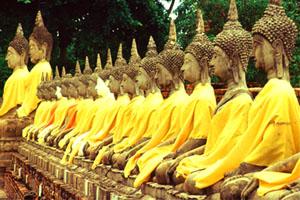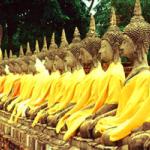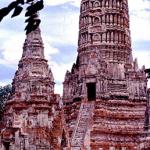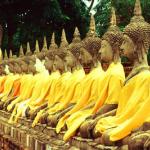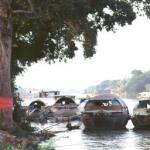Ayutthaya
Bangkok nowadays has grown to such a size that visitors may be forgiven for thinking that it has always been the capitol of Thailand. But this is not the case. In fact, since the 13th century it is the third such, the other two capitols being in the north at Sukhothai (1238-1351 AD) and Ayutthaya. Bangkok has only been the center of government since 1782 and the present Grand Palace that just about everyone visits here was actually modeled on the style of the old palace in Ayutthaya. For more than 400 years, 1351-1767, Thailand was governed from Ayutthaya in an era known by historians as Thailand's "Golden Age."
At its height, the ancient city of Ayutthaya was a truly thriving center of a nation that was the most powerful in Southeast Asia for several centuries until its sacking and plundering by the Burmese in 1767. In their lust to take over the commercial center that Ayutthaya had become because of its control over lucrative trade routes, the Burmese destroyed many of the Angkor style temples and took unlimited amounts of wealth in the form of artefacts and jewels back to Burma. Although they were driven out less than six months later, the Burmese had ended Ayutthaya's reign as a capitol city due to the thoroughness of their destruction of what had been the "jewel of the East."
However, perhaps because of the proximity of Bangkok to Ayutthaya (86 km) it is once more a thriving town of more than half a million people and the ruins of the Ayutthaya civilization attract many visitors in their own right. As do the colorful markets, fine floating restaurants and pleasant quietude you are surrounded by compared to boisterous Bangkok.
In order to best protect their home, the ancient rulers of Ayutthaya utilized three nearby rivers which they connected by man-made canals to surround their stunning city, making a mostly natural moat around the city that served to ward off invaders. They were courted during those times by savvy Japanese merchants who built their own settlement just outside the city, on the other side of the moat, and were soon joined by other settlements constructed by English, French and Portuguese traders from Europe.
The Kings who ruled Ayutthaya constructed walls and fortresses as well as the moat that surrounded them, the remnants of which can still be glimpsed at certain points in the old part of the city. And of the hundreds of temples that were built, there is enough remaining of them today to enable you to imagine yourself back in Thailand's golden era of prosperity. If you close your eyes for a moment in the proximity of an ancient ruin it is not difficult to picture throngs of silken clad Thais in their national dress of baggy trousers cut off at the calf going about their business of the day. The city today is still surrounded by the three rivers (the Chao Phraya, Lop Buri and Pa Sak) and a good way to visit the city is to take the three and a half hour boat trip up the Chao Phraya from Bangkok, returning by road or train which is about an hour and a half trip.
When visiting Ayutthaya, in order to get a taste of the city, a good idea is to travel by boat again, taking a circumnavigatory tour of the island. Boats leave from the pier by the market and the trip lasts about an hour. You will pass by Wang Luang (the remains of the old wooden palace buildings), Wat Phra Si Sanphet, Wat Phra Ram, Wat Ratchaburana, the Ayutthaya Study Center and two museums - the Chao Sam Phraya and Chandra Kasem.
Your short boat trip around the island will set you up for further exploration by giving you some ideas of where you would like to explore. One temple that you might find particularly interesting is the aforementioned Wat Phra Ram, which was founded in 1369. It is set in a delightfully laid out garden with lotus blooms floating in a pond surrounded by the enigmatic ruins of the temple. The sight begs the question of how the people in those times could have designed and decorated such complex and and artistic structures with the technology they possessed.
Another ancient temple worth visiting, that is still in good repair, is Wat Phra Si Sanphet which was founded in approximately 1448. Its three bell-shaped chedis (monuments enshrining holy Buddhist relics) are flanked by two columns of viharas (assembly halls and chapels) and surrounded by sandstone images of Lord Buddha.
Before leaving Ayutthaya, a must, if you want to go home with long-lasting memories, is a visit to the Chao Sam Phraya Museum. There you'll see how Siam was influenced by the Mon and Khmer civilizations. You will see well-preserved remains of Buddha images and mythological images from Thailand, India and Sri Lanka. And you will also have the chance to see some fabulous glittering treasures of gold and jewelry in the museum's east room that were found in Wat Ratchaburana, luckily one of the only ones not looted by the scavenging Burmese. The regalia of gold on display, the filigreed headdresses, the ornamented war-elephant complete with howdah, a sword with a crystal handle and a scabbard inlaid with precious stones, all of these artifacts and more give a hint as to how fabulous a city Ayutthaya must once have been.
 ThingsAsian
ThingsAsian